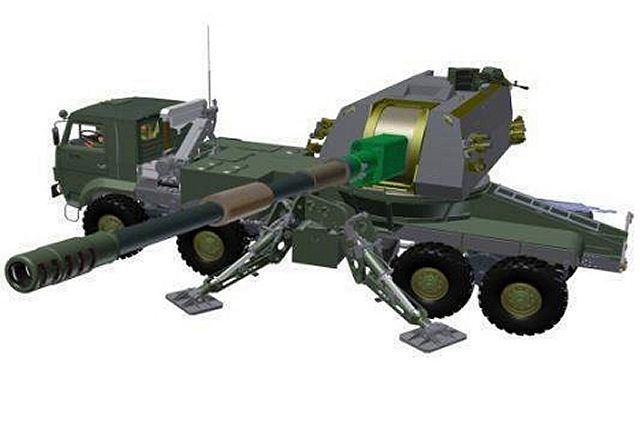KamAZ spokesman Oleg Afanasyev told Izvestiya that the
new howitzer will be based on the four-axle KamAZ-6560 truck, which
has a history of construction and military applications. The platform
underwent minor modifications to accommodate the Koalitsiya piece, including
the installation of a more powerful engine and a reinforced frame to
withstand the recoil.
"This is essentially the platform used in the Pantsir-S SAM system,"
Afanasyev explained. "It meets the factory and military specifications.
It is also in production, which means there will be no production-entry
hiccoughs."
According to Afanasyev, a prototype Koalitsiya platform has been shipped
to the Motovilikhinskiye Zavody factory in Perm in Russian Urals, which
manufactures the howitzer. Factory testing of the complete item is expected
to last until late 2015, and will lead up to the official commissioning
of the new weapon.
The new howitzer will reportedly be fully automatic, meaning that the
crew will remain in the armoured cab for the loading and firing sequence.
Sources at the Defence Ministry told Izvestiya that the howitzer is
primarily intended as an asset for assault and light mountain brigades,
which require mobility and high road speeds. Lesser-priority recipients
are medium brigades, which currently use wheeled armoured personnel
carriers (APC) instead of tracked infantry fighting vehicles to transport
personnel. Heavy brigades are expected to be armed with tracked vehicles,
which are normally better armoured than wheeled vehicles.
Sources at the Missile Troops and Artillery Department of the Russian
Ground Troops Command told Izvestiya that the KamAZ-based Koalitsiya
howitzer would supplement the previously ordered superlight howitzer.
Independent military expert Vyacheslav Tseluyko says the Koalitsiya
howitser will find limited use.
"This type of howitzer would best fit the needs of medium brigades
with APCs, whose high share of wheeled vehicles and fairly high marching
speed would warrant the addition of such an asset," he explains.
"Tracked Msta-S howitzers or towed Msta-B howitzers would slow
down the advance of a marching convoy within such units. On the other
hand, the howitzer would prove useless for light brigades because it
is too big to fit into an Mi-26 [transport helicopter], which is a mandatory
parameter for light weapons [operated under the Russian military system]."
Tseluyko also notes that the Russian Ground Troops have previously attempted
to develop a wheeled howitzer with the Msta-K barrel, but failed because
the wheels were not sturdy enough to withstand the recoil loads.
The Koalitsiya-SV howitzer was developed by Nizhny Novgorod-based Burevestnik
research institute, and entered production at Motovilikhinskiye Zavody
in Perm.
Mock-ups of Koalitsiya family artillery systems, to be based on various
chassis, were first demonstrated during Deputy Prime Minister Dmitry
Rogozin's visit to Perm in July 2012.
It was at that time that Motovilikhinskiye Zavody proposed its grounds
as the venue for a federal centre of innovative artillery technology,
which was expected at the time to include Burevestnik and Yekaterinburg-based
Artillery Plant No 9.
|















